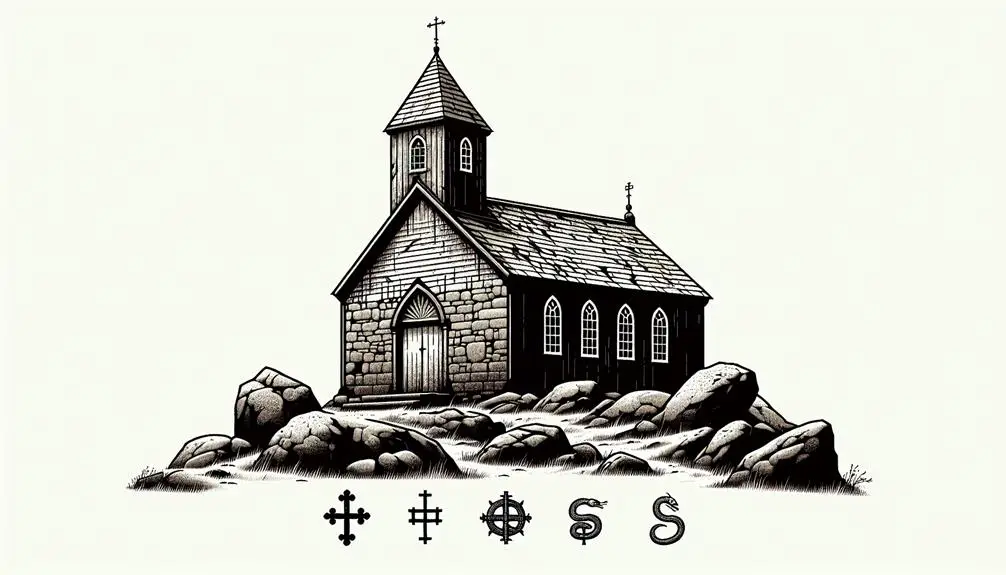Kneel into the history of Biblical church names, uncovering lessons veiled in their identities, and why they still resonate today.

Church Names in the Bible
Have you ever wondered why the churches in the Bible carry such distinct names? From Ephesus, known as the Loveless Church, to Sardis, labeled the Dead Church, each name encapsulates not just an identity but a profound lesson.
You're about to embark on a journey through history and metaphor, where names reveal more than just geographical locations. They mirror the spiritual state, challenges, and commendations of early Christian communities.
As we explore these ancient congregations, you'll uncover the relevance of their stories in today's context, inviting a deeper reflection on your own community's spiritual health.
Key Takeaways
- Church names in the Bible symbolize spiritual conditions, like Ephesus representing lovelessness.
- Biblical church narratives offer cautionary tales and calls for spiritual reformation.
- Each church's story reflects challenges in faith, from persecution in Smyrna to complacency in Sardis.
- Lessons from these churches provide blueprints for modern spiritual awakening and renewal.
Ephesus: The Loveless Church

In analyzing the church of Ephesus, it's crucial to recognize its depiction as the Loveless Church, a title that underscores a significant deviation from the foundational Christian principle of love. This characterization isn't merely a superficial label but a profound critique of the church's spiritual condition, pointing towards a loss of the fervent love that should epitomize Christian communities. The Ephesian church, despite its strong doctrinal stance and resilience against false teachings, is admonished for having forsaken its first love. This critique serves as a stark reminder that orthodoxy, without love, is insufficient in the Christian faith.
The call for an Ephesian revival, therefore, isn't just a call to correct doctrinal errors or to enhance religious practices. It's a deeper, more fundamental call for Love restoration. This entails a return to the passionate and unconditional love for God and for one another that marked the early Christian community. Such a revival necessitates a heart transformation that rekindles the initial fervor and devotion, ensuring that love remains the core of the church's identity and mission.
Analyzing the Ephesian church's journey towards Love restoration provides invaluable insights into the dynamics of spiritual decline and revival. It highlights the dangers of complacency and the critical need for continual self-examination and renewal in love. As a model, the Ephesian revival underscores the indispensable role of love in sustaining the vitality and witness of the church. It serves as an enduring lesson that true spiritual vitality is inextricably linked to the primacy of love in the life of the church.
Smyrna: The Persecuted Church

ARTICLE TITLE: Names of Churches in the Bible
PREVIOUS SUBTOPIC: 'Ephesus: The Loveless Church'
CURRENT SUBTOPIC: 'Smyrna: The Persecuted Church'
Moving from the internal struggles of Ephesus, we now turn our attention to Smyrna, known as the Persecuted Church, facing external tribulations that tested its faith and resilience. Unlike Ephesus, Smyrna's challenges weren't born from within but were rather imposed by severe persecution from external forces. This adversity, however, didn't weaken Smyrna; it showcased Smyrna's resilience, becoming a testament to overcoming adversity through steadfast faith.
Smyrna's experience offers profound insights into the dynamics of faith under pressure. The persecution it faced wasn't merely a test of endurance but also a refinement of its collective spirit and dedication. This church's story underscores the paradox of strength in vulnerability—how, through facing adversities head-on, it not only survived but thrived, its faith purified and its community more unified.
Aspect |
Significance |
|---|---|
External Trials |
Highlighted the church's vulnerability and faith. |
Community Unity |
Fostered a stronger, more cohesive community. |
Spiritual Growth |
Led to deeper faith and reliance on divine support. |
Analyzing Smyrna's journey, it's evident that the church's ability to endure, and even embrace, its trials was pivotal. The narrative of Smyrna isn't just one of suffering; it's a narrative of triumph over adversity, a compelling story of a community's resilience and its unyielding faith in the face of daunting challenges. Through Smyrna's example, the timeless lesson is clear: overcoming adversity is not just about survival but about emerging stronger, more faithful, and united.
Pergamum: The Compromising Church

Shifting our focus to Pergamum, we encounter a church that notably grappled with the issue of compromising its doctrinal purity in the face of societal pressures. Pergamum's location played a pivotal role in this narrative. Situated as a prominent cultural and religious hub, it was exposed to diverse beliefs and practices, which inevitably influenced the church community. This exposition laid a fertile ground for the Nicolaitans' teaching to seep in, challenging the church's foundational doctrines.
Analyzing the situation, we can identify several critical aspects:
- Pergamum's Strategic Location: Positioned in Asia Minor, Pergamum wasn't just a political center but also a melting pot of various religious practices. This environment tested the church's resilience against external influences.
- Challenges from Nicolaitans' Teaching: The Nicolaitans propagated teachings that were antithetical to Christian doctrine, promoting a syncretism that diluted the purity of the gospel. Their presence in Pergamum posed a significant threat to the church's spiritual integrity.
- The Church's Compromise: The pressure to conform to the surrounding society led some in the Pergamum church to compromise their beliefs, blurring the lines between Christian doctrine and pagan practices.
- The Call to Repentance: Despite these challenges, the call to repentance and reformation was clear, emphasizing the need for the church to re-anchor itself in its foundational truths, resisting the temptations to compromise.
Thyatira: The Corrupt Church

Turning our attention to Thyatira, we encounter a church deeply embroiled in corruption, marking a stark contrast to the compromising nature of Pergamum. This city's economic life was dominated by trade guilds, which wielded significant influence not only in commerce but also in the social and religious practices of the community. Membership in these guilds often required participation in activities that conflicted with Christian beliefs, leading to a complex web of moral and ethical dilemmas for believers.
The story of Lydia's conversion, as recorded in the Acts of the Apostles, provides a notable counterpoint to the prevailing culture of Thyatira. Lydia, a dealer in purple cloth, represents a positive intersection of faith and commerce, indicating that while the environment in Thyatira was challenging, it was not without its beacons of faithfulness and integrity.
Analyzing the church at Thyatira reveals a multifaceted struggle between adherence to faith and the pressures exerted by the surrounding culture, heavily influenced by the trade guilds. This tension is emblematic of the broader challenges faced by early Christians as they navigated their place within a predominantly pagan society.
Aspect |
Description |
|---|---|
Trade Guilds |
Played a pivotal role in the city's economy, often at odds with Christian values. |
Lydia's Conversion |
Demonstrates the possibility of maintaining Christian integrity in a compromising environment. |
Economic Influence |
Led to moral compromises among believers, diluting the church's purity. |
Cultural Conflict |
Highlighted the tension between Christian ethics and societal norms. |
In synthesizing these elements, Thyatira's narrative serves as a cautionary tale about the dangers of allowing external influences to corrupt the core values of the church.
Sardis: The Dead Church

In contrast to the complex moral landscape of Thyatira, the church in Sardis presents a starkly different scenario, epitomizing spiritual decline despite outward appearances of vitality. This analysis delves into the characteristics that defined Sardis as the 'Dead Church,' underscoring the urgent need for a spiritual awakening.
The narrative surrounding Sardis in Scripture serves as a poignant reminder of the dissonance between outward success and inner spiritual life. The call for a Sardis revival isn't merely historical; it echoes through ages, urging modern congregations to introspect and rejuvenate their spiritual fervor.
Consider these aspects that marked Sardis and necessitated a call for revival:
- Complacency: Sardis had grown comfortable, mistaking routine for faithfulness. Their spiritual lethargy was a significant barrier to genuine spiritual awakening.
- Reputation Over Reality: They'd a name for being alive, but in reality, were dead. This discrepancy highlights the danger of prioritizing external perception over authentic spiritual vitality.
- Unfinished Works: Despite their activities, their works weren't found perfect before God. This indicates a superficial engagement with their faith, lacking depth and commitment.
- Call to Wakefulness: The admonition to 'wake up' and strengthen what remains serves as a clarion call for spiritual revival. It underscores the necessity of vigilance and constant renewal in one's faith journey.
The narrative of Sardis serves as a stark caution, yet also offers hope. A spiritual awakening is possible, but it demands earnest self-reflection, repentance, and a heartfelt return to the fundamentals of faith. The Sardis revival is more than a historical anecdote; it's a blueprint for rejuvenating a community's spiritual life today.
Frequently Asked Questions
How Do Modern-Day Churches Use the Lessons From the Biblical Churches in Their Teachings and Practices?
In modern times, you'll see churches drawing lessons from biblical examples to shape their teachings and practices. They've adapted church architecture to reflect the spiritual significance and communal aspects, reminiscent of early gatherings.
Similarly, worship styles have evolved, incorporating traditional hymns and contemporary music, aiming to connect with a diverse congregation while maintaining a thread to their scriptural roots. This blend of old and new enriches the spiritual experience, offering a bridge between past and present.
Are There Any Biblical Churches Mentioned Outside of the Revelation to John, and How Do They Compare?
Interestingly, you're exploring churches outside Revelation, like those involved in Temple Worship and Synagogue Roles, which significantly shaped early Christian practices. These institutions, found throughout the New Testament, offer a rich comparative study.
They were central to community life, providing spiritual, educational, and judicial functions. Analyzing their evolution and influence on modern congregations offers a nuanced understanding of how early Christian communities navigated their faith and societal roles, shedding light on contemporary practices.
How Have the Geographical Locations of These Ancient Churches Influenced Christian Pilgrimage and Archaeology Today?
The geographical locations of these ancient sites have significantly influenced Christian pilgrimage and archaeology, impacting tourism and highlighting their cultural significance.
As you explore these areas, you'll uncover how their historical context enriches our understanding of early Christian communities.
This exploration not only fosters a deeper appreciation for their spiritual heritage but also stimulates economic growth in regions, attracting scholars and tourists eager to connect with Christianity's foundational moments.
In What Ways Have the Interpretations of the Messages to These Churches Evolved Throughout Christian History?
Imagine you're unearthing a time capsule, revealing layers of historical contexts and theological interpretations. Over time, the way you understand these ancient messages, like that time capsule, has evolved.
Scholars and believers have continually reinterpreted the messages, considering the historical contexts in which they were written and how these contexts influence theological interpretations today. This dynamic process shows the living nature of religious texts, adapting and resonating through ages.
What Role Do These Church Narratives Play in Contemporary Inter-Denominational Dialogues and Ecumenical Movements?
You're diving into how narratives shape discussions across different church denominations today, focusing on ecumenical challenges and denominational identity.
These stories aren't just ancient texts; they're at the heart of dialogues aiming to bridge doctrinal divides. By examining them, you're unpacking how churches navigate their unique identities while striving for unity.
It's a complex dance of respecting differences yet seeking common ground, crucial for fostering understanding and cooperation among diverse faith communities.
Conclusion
In analyzing these biblical church names, it's evident each embodies a unique spiritual condition, reflective of both historical context and timeless human challenges.
Consider, hypothetically, a modern congregation grappling with the same issues as the Church in Ephesus, losing its first love amidst growing secular pressures.
This example not only humanizes these ancient critiques but also serves as a poignant reminder of the perpetual struggle to maintain spiritual integrity in a rapidly changing world, urging a return to foundational love and faith.



Sign up